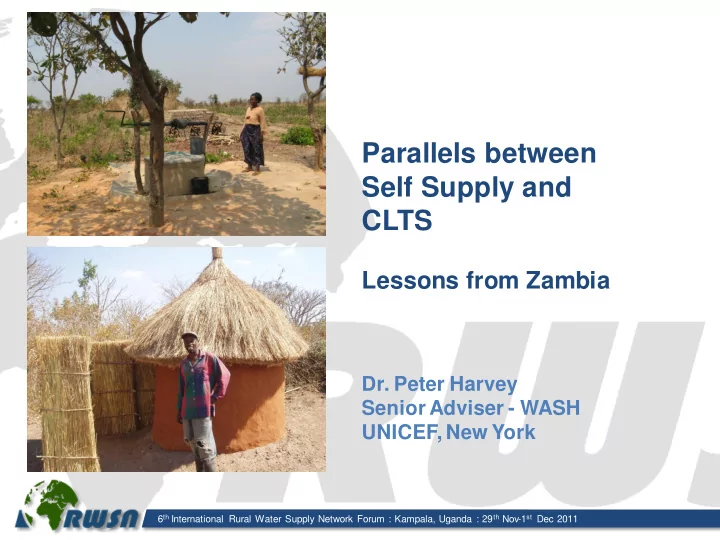

Parallels between Self Supply and CLTS Lessons from Zambia Dr. Peter Harvey Senior Adviser - WASH UNICEF, New York 6 th International Rural Water Supply Network Forum : Kampala, Uganda : 29 th Nov-1 st Dec 2011
Outline • Comparative analysis: – Triggering – Household dynamics – Community dynamics – Self-financing – Private sector role – Quality of outputs – Links with sustainable development – Scaling up process • Conclusions and recommendations 6 th International Rural Water Supply Network Forum : Kampala, Uganda : 29 th Nov-1 st Dec 2011
Triggering • CLTS uses negative emotions – shame, disgust – and peer pressure to stimulate positive action. • Self Supply triggering is more gradual and uses positive triggers such as status and prestige. • Both respond to suppressed demand for improved living standards and enhanced quality of life. 6 th International Rural Water Supply Network Forum : Kampala, Uganda : 29 th Nov-1 st Dec 2011
Household dynamics • Sanitation is primarily a Number of people per toilet household responsibility – (before triggering) CLTS target: ‘one family, one Number of people per toilet (9 months after triggering) toilet’. Average household size • Traditional water sources are 0 10 20 often privately owned but Number of people shared. • Key actions take place at Communally owned household level in both approaches. Privately owned (not shared) • Both approaches promote Privately owned and shared equity through support to poorer households. 0 50 100 Proportion of facilities (%) 6 th International Rural Water Supply Network Forum : Kampala, Uganda : 29 th Nov-1 st Dec 2011
Community dynamics • CLTS triggering results in a Toilet coverage (before triggering) community commitment to Toilet coverage (9 months achieve ODF status. after triggering) • Self Supply water sources Proportion of communities ODF serve smaller communities. 0 20 40 60 80 • Peer pressure and Percentage (%) competition play important Number of households roles in the cascade effect >50 served in both approaches. 21-50 • Both approaches stimulate 1-20 the desire to ‘keep up with 0 20 40 60 80 the neighbours ’. Proportion of facilities (%) 6 th International Rural Water Supply Network Forum : Kampala, Uganda : 29 th Nov-1 st Dec 2011
Self-financing • Both approaches are zero subsidy strategies. • The emphasis is on self-sufficiency and self-determination of what is most appropriate. • Costs in Self Supply are generally higher and micro-credit facilities are needed for some households. • Self-financing is essential to ensure self-sufficiency, sustainability and scalability. 6 th International Rural Water Supply Network Forum : Kampala, Uganda : 29 th Nov-1 st Dec 2011
Private sector role • Skilled artisans are needed in both approaches. • The emphasis is on locally available materials, skills and experience. • Local solutions and innovations are encouraged. • Private sector responds to stimulated demand. • Self Supply requires greater emphasis on private sector capacity development. 6 th International Rural Water Supply Network Forum : Kampala, Uganda : 29 th Nov-1 st Dec 2011
Quality of outputs 100 80 Toilets in use 90 Protected (47) 70 Proportion of samples (%) Proportion of toilets (%) 80 Toilets with Semi-protected (58) 60 70 superstructures Unprotected (72) 50 60 Toilets with lid 40 50 Smooth and clean 40 30 squatting surface 30 20 Covered toilets 20 10 10 Toilets with handwashing 0 0 facilities <10 10-100 >100 Faecal coliform counts/100ml 6 th International Rural Water Supply Network Forum : Kampala, Uganda : 29 th Nov-1 st Dec 2011
Sustainable development • CLTS and Self Supply are true empowerment and development strategies. • They represent a paradigm shift from sustained dependency to sustained development. • The incremental nature of improvement allows households to determine their own pace of development. • Opportunities are created for other development activities: tree planting, food security, income generation etc. 6 th International Rural Water Supply Network Forum : Kampala, Uganda : 29 th Nov-1 st Dec 2011
Scaling up • Factors in rapid scale up of CLTS: – Government involvement – On-going review & evaluation – Documentation – Local and national media engagement – Role of traditional leaders – Wide range of stakeholders • Both approaches create a cascade effect but Self Supply moves more slowly – from household to household rather than community to community. HRH Chief Macha Winner of the AfricaSan Leadership Award 2009 6 th International Rural Water Supply Network Forum : Kampala, Uganda : 29 th Nov-1 st Dec 2011
Conclusions • Many commonalities between the two approaches. • Self Supply triggering process can be refined to stimulate emotional responses. • Role of a wider range of stakeholders including traditional leaders and media can be used to scale up Self Supply. • Opportunities exist for integrated implementation of CLTS and Self Supply. 6 th International Rural Water Supply Network Forum : Kampala, Uganda : 29 th Nov-1 st Dec 2011
Thank You Hand up not hand out! 6 th International Rural Water Supply Network Forum : Kampala, Uganda : 29 th Nov-1 st Dec 2011
Recommend
More recommend